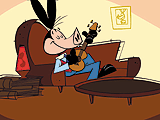F. Rank Shaughnessy gives us a sneak peek at his book which outlines the evolution of Elmo Aardvark, including the characters long-standing presence in Internet culture.
The following are excerpts from Mr. Shaughnessy's upcoming monograph of the same title.
Elmo Aardvark was a popular icon on ARPAnet, the precursor to the Internet. Graphic representations of his famous three-quarter profile were "drawn" with dot-matrix printed symbols that approximated the traditional outline. Printed out onto large sheets of computer paper, these homemade posters would hang on the walls of avant-garde hackers in the 1970s and 80s.

Fans can listen to all the classic tunes from Americas most classic toon.
The U.S. government's well-documented "secret" espionage operation headquartered in England in the early 70s had several benign, misleading code names for each of its different divisions, one of which was originally "Operation Elmo Aardvark." This code name was later informally changed to "World Wide Wiretap," which was abbreviated as "www." For obvious reasons the interpretation of "www" was later given to the public as "World Wide Web."
After years of ubiquity as a static, yet jovial, presence, Elmo Aardvark was finally animated on Usenet in the early 1990s. With government funding, SnappyToons had formed a wholly-owned operating division, SnappyToons CyberSpace Exploration and Mining Company, which subcontracted with various animators to design experimental animation.
Elmo Aardvark was thus seen in simplistic animated form on Usenet's ASCII newsgroup, using only two or three images to form an action: waving, laughing, winking, etc. Film director and occasional MENSA lecturer Mike Jittlov was the first artist authorized by SnappyToons to animate Elmo Aardvark on the Web. "For the life of me I can't tell you how I did it anymore," said Mr. Jittlov in a recent telephone interview from his Hollywood Hills home. "As I recall, you posted different pictures, one after the other, and there was a small bit of code that would enable someone with the right newsreader to see the animated action. At the time it was kind of a primitive novelty, but quite miraculous in its own way."
President of the Vancouver media production company Ones & Zeroes Terry McEvoy was the first Canadian licensed to animate Elmo Aardvark. But as time went on, provincialism prevented progress. Apart from having to create programming in two languages, Mr. McEvoy observed in a 1996 in-house article that "the Saskatchewan government's archaic Tropical Image Ban has forced us to postpone distribution of our digital opera, Boolean Hula with Oola and Loola, indefinitely. This universally unpopular law has yet to be repealed. A letter or e-mail might help bring the provincial premier to his senses."
Animated icons for the Macintosh were the next wave of Internet Elmo Aardvark animations. Reportedly, animator Steve Segal was involved in their development. Animated gifs created and seen by Web cognoscenti were occurring around the same time.

Elmo is back in new adventures with Elmo Aardvark: Outer Space Detective! © Will Ryan.
Despite the loss of government funding, the last few years have seen continued experimental Web animation with Elmo Aardvark. Authorized work created by SnappyToons, Renegade Animation, Chris Casady, Leslie Cabarga and Mel Ramirez could be viewed on various closed and open-to-those-in-the-know Web sites.
Since 1997, simple Elmo Aardvark cartoons have run on an average of two or three a week in "rehearsal halls," as SnappyToons CEO Will Ryan has termed such unpublicized experimental Web sites.
Elmo Aardvark's "official" Web debut, on renegadecartoons.com, will be Elmo Aardvark: Outer Space Detective! Although it premiers in April, 2000, the ukulele-strumming cartoon star has been on that site continuously since mid-1997.
Elmo Aardvark: Outer Space Detective! will use Flash software, a decision reached in 1999 "because of its ability to stream quickly and, if you know how to do it right, efficiently," says director Darrell Van Citters.
"In addition," reveals producer Ashley Postlewaite, "we hear that all of the guys at Macromedia are geniuses."
F. Rank Shaughnessy is a senior fellow with the Brinckloe Institute and is a frequent lecturer on new media. His book Behind the Meaning of Semiotics (Carswell Press) will be published in Fall 2000.







